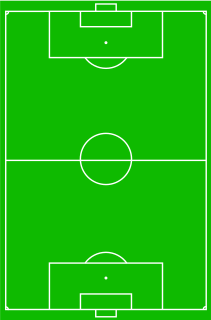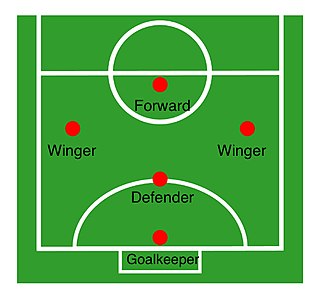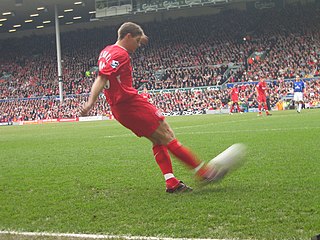
Field hockey is a team sport of the hockey family. Each team plays with ten field players and a goalkeeper, and must carry a round, hard, plastic hockey ball with a hockey stick to the rival goal.

In many team sports which involve scoring goals, the goalkeeper is a designated player charged with directly preventing the opposing team from scoring by blocking or intercepting opposing shots on goal. Such positions exist in bandy, rink bandy, camogie, association football, Gaelic football, international rules football, floorball, handball, hurling, field hockey, ice hockey, roller hockey, lacrosse, ringette, rinkball, water polo, and shinty as well as in other sports.

Forwards are the players on an association football team who play nearest to the opposing team's goal, and are therefore most responsible for scoring goals.

A midfielder is an association football position. Midfielders are generally positioned on the field between their team's defenders and forwards. Some midfielders play a strictly-defined defensive role, breaking up attacks, and are otherwise known as defensive midfielders. Others blur the boundaries, being more mobile and efficient in passing: they are commonly referred to as deep-lying midfielders, play-makers, box-to-box, or holding midfielders. The number of midfielders on a team and their assigned roles depends on the team's formation; the collective group of these players on the field is sometimes referred to as the midfield.
In the sport of association football, a defender is an outfield player whose primary roles are to stop attacks during the game and prevent the opposing team from scoring goals.
There are various individual skills and team tactics needed to play effective association football. Football is in theory a very simple game, as illustrated by Kevin Keegan's famous assertion that his tactics for winning a match were to "score more goals than the opposition". However, well-organised and well-prepared teams are often seen beating teams with supposedly more skillful players, even over time. Coaching manuals and books generally cover not only individual skills but tactics as well. Some of the tactics include using a 4-4-2 formation which is often regarded as the standard formation, a formation of 5-4-1 which is more defensive and a 4-3-3 formation which allows for more attacking play.

In the sport of association football, each of the 11 players on a team is assigned to a particular position on the field of play. A team is made up of one goalkeeper and ten outfield players who fill various defensive, midfield, and attacking positions depending on the formation deployed. These positions describe both the player's main role and their area of operation on the pitch.

In the game of rugby union, there are 15 players on each team, comprising eight forwards and seven backs. In addition, there may be up to eight replacement players "on the bench", numbered 16–23. Players are not restricted to a single position, although they generally specialise in just one or two that suit their skills and body types. Players that play multiple positions are called "utility players".
In certain sports, such as football, field hockey, ice hockey, handball, rugby union, lacrosse and rugby league, winger is a position. It refers to positions on the extreme left and right sides of the pitch, or playing field. In American football and Canadian football, the analogous position is the wide receiver. Wingers often try to use pace to exploit extra space available on the flanks that can be made available by their teammates dominating the centre ground. They must be wary however of not crossing the touchline, or sidelines, and going out of play. In sports where the main method of scoring involves attacking a small goal in the centre of the field, a common tactic is to cross the ball to a central teammate.
A rugby league team consists of thirteen players on the field, with 4 substitutes on the bench. Each of the thirteen players is assigned a position, normally with a standardised number, which reflects their role in attack and defence, although players can take up any position at any time.
In sports, a utility player is one who can play several positions competently. Sports in which the term is often used include association football, American football, baseball, rugby union, rugby league, softball, ice hockey, and water polo.

In sports, a starting lineup is an official list of the set of players who will participate in the event when the game begins. The players in the starting lineup are commonly referred to as starters, whereas the others are substitutes or bench players.

Like most forms of modern football, rugby league football is played outdoors on a rectangular grass field with goals at each end that are to be attacked and defended by two opposing teams. The rules of rugby league have changed significantly over the decades since rugby football split into the league and union codes. This article details the modern form of the game and how it is generally played today, however rules do vary slightly between specific competitions.

In the sport of Australian rules football, each of the eighteen players in a team is assigned to a particular named position on the field of play. These positions describe both the player's main role and by implication their location on the ground. As the game has evolved, tactics and team formations have changed, and the names of the positions and the duties involved have evolved too. There are 18 positions in Australian rules football, not including four interchange players who may replace another player on the ground at any time during play.

In association football, a playmaker is a player who controls the flow of the team's play, and is often involved in offensively and defensively play passing moves which lead to goals, through their vision, technique, ball control, creativity and passing ability.

The following are the positions in the Gaelic sports of Gaelic football, hurling and camogie.

Squad numbers are used in association football to identify and distinguish players that are on the field. Numbers were originally used to also indicate position, with starting players being assigned numbers 1–11, although these numbers often bear little or no significance in the modern game other than the players' favourite numbers and the numbers available. However, numbers 1–11 are often still worn by players of the previously associated position.

This is the list of futsal positions, with a brief explanation of what the position is and notable futsal players of that position. The positioning of these players can attribute to different strategies during the game.

In association football, a cross is a medium- to-long-range pass from a wide area of the field towards the centre of the field near the opponent's goal. Specifically, the intention of a cross is to directly bring the ball into the box from an angle that allows the attacking forwards to more easily aim for goal with their head or feet. Crosses are generally airborne (floated) to clear nearby defenders, but can also be hit with force along the ground (drilled). It is a quick and effective move.
Zona mista, often referred as Mixed Plan and, in the English-speaking world, to as The Game in Italian Style ; is a tactic used in Italian association football mainly from the second half of 1970s to the mid-1990s. The introduction of this system has been attributed to Luigi Radice and Giovanni Trapattoni, then coaches of Torino and Juventus, respectively. The tactic reached the highest sporting level with Juventus headcoached by Trapattoni becoming the first club in history to reach the European Treble having won the then three seasonal UEFA competitions and, in 1985, the first European side to win the Intercontinental Cup since it was restructured five years before, becoming world champion, and the Italian national team, managed by Enzo Bearzot, which won the FIFA World Cup in 1982, for the first time since 1938, with notable participation from the Blocco-Juve; making both teams acclaimed as among the greatest in sports history.
















